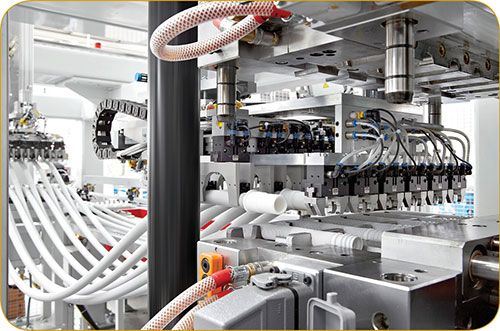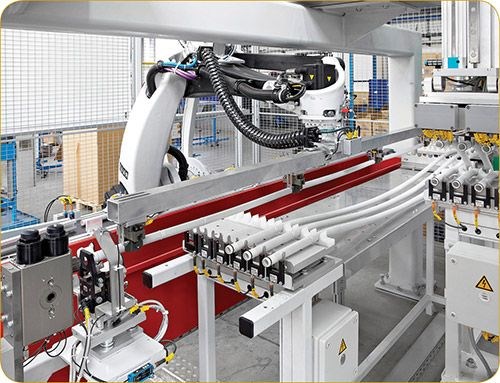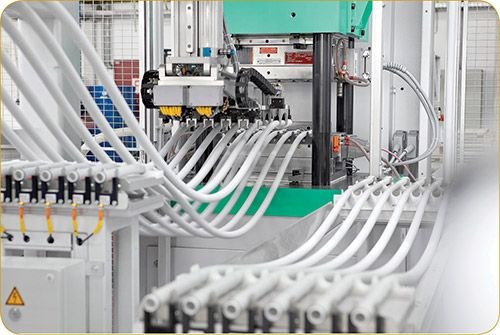Extrusion & Injection Molding in One Automated Process
Close Up: Injection Molding
A large German manufacturer of hoses, cable ducts, and other extruded automotive components recently expanded its activities into the white-goods appliance sector.
A large German manufacturer of hoses, cable ducts, and other extruded automotive components recently expanded its activities into the white-goods appliance sector. Its largest project to date involves extruding corrugated hoses and molding fittings (with an inserted O-ring) onto both ends. The need was for high-volume production of high-quality but inexpensive hoses for Germany’s largest dishwasher manufacturer. “The ideal system is one where the plastic granulate is filled in at one end and ready-to-ship hoses come out at the other,” says Roland Meissner, division manager of Air & Fluid Systems at Schlemmer GmbH in Hassfurt. “This ensures consistently high quality around the clock. And compared with two-stage production, it saves the costs for intermediate storage.”
Achieving the ideal required combining extrusion and injection molding into a flexible, automated production cell. “Our first criterion when selecting a suitable supplier was a turnkey system, as we wanted everything from a single source,” says Meissner. Schlemmer found that source in Arburg GmbH (U.S. office in Newington, Conn., arburg.us). Arburg acted as general contractor and also supplied a 100-metric-ton Allrounder vertical-clamp insert-molding press. Other project partners were Straberger for the injection mold, FPT Robotik for automation, Ohrmann for O-ring placement, and Furness Controls for leak testing. The entire system was commissioned in only eight months.
HOW IT WORKS
A number of challenges had to be overcome. “The extruded PP hose material cannot be handled when cold, as so-called stress whitening occurs,” explains Schlemmer process technician Hubert Rausch. “However, the warm material shrinks by several centimeters during the production process, which must be compensated for by the three robotic systems during handling.” Moreover, about a dozen significant dimensions must be maintained on the hose body.
Schlemmer devised a technique using three blades to cut the hose to a precision of 0.1 mm. Off-spec parts are detected automatically by a photoelectric barrier. Good parts are picked up by a four-axis robotic system from Kuka Robotics (U.S. office in Clinton Township, Mich., kuka-robotics.com) and transferred to an O-ring placement station. This takes care of the most difficult task: precise positioning of six flexible hoses, each 2.25 meters long, for O-ring insertion.
Two synchronized FPT linear robots then grip the front and rear of the hoses. The linear robots handle 12 parts in a single operation. They remove six hoses with the molded-on TPE fittings and insert six new ones. The finished hoses are set down to cool in an intermediate station.
At the same time, the Allrounder press (Schlemmer’s first vertical machine) injects six fittings in a cycle time of about 30 sec. “Despite the progressive shrinkage, a perfect join must be created between the hose body and fitting, without any over- or under-injection,” notes Rausch. “In this respect, Arburg and the mold manufacturer have contributed a lot of expertise. We’re currently working on speeding up extrusion while also further reducing the injection molding cycle time.”
The linear robots then transfer the cooled hoses to the next station for leak testing. Rejects are again removed and the other hoses are bundled into batches of 50. Six hoses pass through the entire cell in about 35 sec.
This system has been in production since early this year. To make this complex system easier to use, the robots use the same Selogica user interface as the Arburg injection machine. The two linear robots have a single controller, which is networked with the four-axis robot.
Related Content
How Polymer Melts in Single-Screw Extruders
Understanding how polymer melts in a single-screw extruder could help you optimize your screw design to eliminate defect-causing solid polymer fragments.
Read MoreFormulating LLDPE/LDPE Blends For Abuse–Resistant Blown Film
A new study shows how the type and amount of LDPE in blends with LLDPE affect the processing and strength/toughness properties of blown film. Data are shown for both LDPE-rich and LLDPE-rich blends.
Read MoreExtruder Alignment: Important, but Only Half the Equation
The other half? Aligning and supporting downstream equipment. Here are best practices.
Read MoreUnderstanding the ‘Science’ of Color
And as with all sciences, there are fundamentals that must be considered to do color right. Here’s a helpful start.
Read MoreRead Next
People 4.0 – How to Get Buy-In from Your Staff for Industry 4.0 Systems
Implementing a production monitoring system as the foundation of a ‘smart factory’ is about integrating people with new technology as much as it is about integrating machines and computers. Here are tips from a company that has gone through the process.
Read MoreUnderstanding Melting in Single-Screw Extruders
You can better visualize the melting process by “flipping” the observation point so that the barrel appears to be turning clockwise around a stationary screw.
Read MoreWhy (and What) You Need to Dry
Other than polyolefins, almost every other polymer exhibits some level of polarity and therefore can absorb a certain amount of moisture from the atmosphere. Here’s a look at some of these materials, and what needs to be done to dry them.
Read More














.png;maxWidth=300;quality=90)















